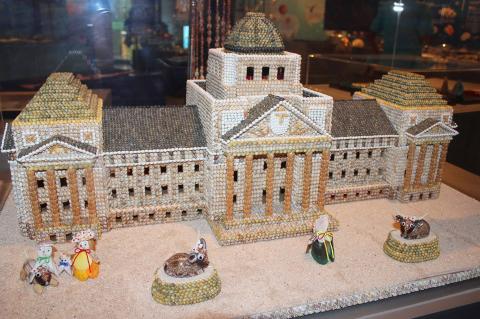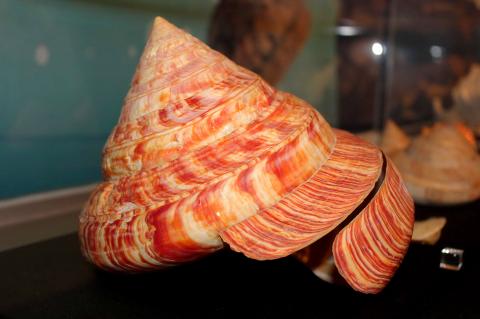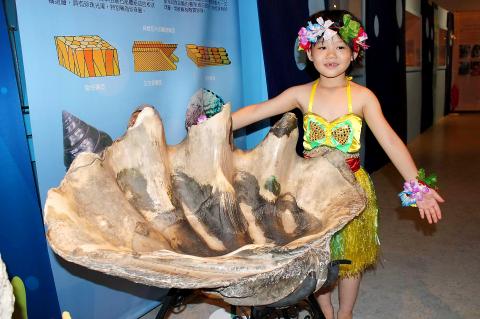Why is it that the sound of the ocean can be heard inside seashells? And why do seashells have such beautiful patterns on them? All of your seashell queries can finally be answered at the Tsailiao Fossil Museum in Greater Tainan when you visit the “Beauty of Seashells Exhibit.” The world’s largest and most precious and unique seashells are on display at the museum, giving people a chance to become better acquainted with seashell cultures and mysteries.
The exhibit will be on display at the Tsailiao Fossil Museum in Zuojhen District until September 23. National Taiwan Museum (NTM) has provided the exhibit with more than 300 seashell specimens from its collection, which includes many unique seashells. There is an area to touch seashells, a film about living Rumphius’ slit shells, as well as information about the relationship between seashells and human culture. Among the items on display, Lai Ching-yang, a member of NTM’s administrative committee for managing its collection, says that the Rumphius’ slit shell on display at the museum, which is valued at NT$380,000, is the most expensive slit shell not only in Taiwan, but in the entire world. Due to their scarcity and as they live very deep in the ocean, finding a Rumphius’ slit shell is far from easy, making them extremely valuable. Some of the Rumphius’ slit shell’s main characteristics include how its shape resembles that of a clock, as well as its long cracks, and the gorgeous flame-like patterns on its surface.
Lai says that although the world’s fourth Rumphius’ slit shell was discovered off the coast of southwestern Taiwan in 1968 by a local fisherman, a Japanese aquarium eventually purchased the shell, making the one preserved on display in Taiwan now even more precious and rare.

Photo: Lin Meng-ting, Liberty Times
照片:自由時報記者林孟婷
Also on display is the world’s largest mollusk, the giant clam, which Lai says can reach up to 1.4m. There is also a replica of the NTM building that was made using more than 20,000 seashells.
(Liberty Times, Translated by Kyle Jeffcoat)
貝殼為何會發出海浪的聲音?貝殼為何有漂亮的紋路?對於貝殼的種種疑問,將可在菜寮化石館所舉辦的「貝殼之美特展」獲得解答,同時展出全世界最貴貝殼、巨大貝殼及各種特殊貝類,讓民眾貼近貝殼文化與奧秘。
「貝殼之美」特展近日至九月二十三日於左鎮菜寮化石館展出,由國立台灣博物館提供三百多件貝殼標本,包括有多種特殊貝類、貝殼觸摸體驗區、龍宮貝活體 影片及人類文化與貝殼的關聯。其中一顆要價新台幣三十八萬的龍宮翁戎螺,國立台灣博物館典藏管理委員會委員賴景陽表示,不僅是台灣最貴、也是全世界最貴的龍宮翁戎螺。龍宮翁戎螺因為非常稀少且只生長在深海,相當難取得所以相對珍貴,其特徵就是外型如鐘型、並有著長裂縫,貝殼表面有漂亮火焰的紋路。

Photo: Lin Meng-ting, Liberty Times
照片:自由時報記者林孟婷
他說,一九六八年漁民在台灣西南海域撈到全世界第四顆龍宮翁戎螺,但被日本水族館買走,所以現在所保存的這顆龍宮翁戎螺是相當珍貴稀有。
此外,世界最大的貝類巨硨磲蛤也展出,賴景陽說,巨硨磲蛤長度可達到一點四公尺;另外還有用兩萬多個小貝殼手工製作出台灣博物館外型的手工藝品。
(自由時報記者林孟婷)

Photo: Lin Meng-ting, Liberty Times
照片:自由時報記者林孟婷

Whether they are a Siamese, Persian, Maine Coon, or Domestic Shorthair, there are hundreds of millions of cats living with people around the world. But despite their popularity as pets, the history of cat domestication has remained difficult for scientists to decipher. A new genome study is providing some insight into the matter by determining the timing of a key milestone in feline domestication - the introduction of domestic cats into Europe from North Africa. Domestic cats pounced into Europe roughly 2,000 years ago in early imperial Roman times, the researchers found, probably thanks to maritime trade. Some of these furry trailblazers

In English, “name idioms” are part of what makes English fascinating. Let’s put a few examples under the microscope. Doubting Thomas This expression stems from the Bible. Thomas, one of Jesus’s disciples, refused to believe Jesus had been resurrected from the dead. He declared he wouldn’t accept it until he could see the nail marks in Jesus’s hands and touch his wounds himself. Today, this idiom refers to someone who won’t believe something without concrete evidence. For instance, if your friend’s expertise is reliable, but you’re still suspicious, you might be a “doubting Thomas.” Smart Aleck The origin of this phrase likely comes from

A: Hey, the world’s major dictionaries just unveiled their words of the year for 2025. B: Yup, the Cambridge Dictionary chose the word “parasocial,” which refers to a connection that someone feels between themselves and a famous person they don’t really know. A: One-sided parasocial relationships with celebrities, influencers and even AI chatbots have clearly become more common. B: The Oxford Dictionary picked “rage bait” — online content designed to elicit anger by being frustrating, provocative or offensive in order to increase traffic to Web sites or social media accounts. A: The Collins Dictionary picked “vibe coding.” Let’s

1. 事故在昨天下午發生。 ˇ The accident happened yesterday afternoon. χ The accident was happened yesterday afternoon. 註︰happen, belong, disappear, fail 是不及物動詞,不能用被動語態。詞組 to break out, to take place 也是如此。 2. 在維多利亞時代,民主是有錢人的特權。 ˇ In the Victorian Age, democratic privileges belonged to the rich only. χ In the Victorian Age, democratic privileges was belonged to the rich only. 註︰belong 是不及物動詞,不能用被動語態。 3. 他雖然一句話也沒說,可是心裏感覺自己是失敗了。 ˇ Though he didn’t say a word, in his heart he felt he had failed. χ Though he didn’t say a word, in his heart he felt he was failed. 註︰fail 是不及物動詞,不能用被動語態。 4. 我們雖然遭受嚴重的天然災害,但一定能克服困難。 ˇ Though we suffer from serious natural disasters, we are sure to overcome all difficulties. χ Though we are suffered from serious